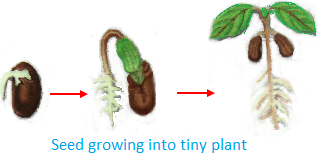Living Things Grow
All living things grow.
Let us see our photograph when we were born. We can see a very small baby in
that picture. Perhaps we cannot recognize that it is our own photo.
When we were born, we were very small. Since then we have been growing continuously. We can look at our photograph when we were about 4 years old. We can look ourselves today. We surely look different. We have grown up. After some years, we will grow into an adult. So, it shows that a child grows into an adult.
Similarly like us, plants and animals also grow.
Seed grow into a tiny plant. A tiny plant grows into a big plant or a tree.
A chick grows into a cock or hen. A kitten grows into a cat.
So, all living things grow.
Now, think about non-living things. Think about the doll with which we played is of the same size even today. The doll has not grown so, non-living things does not grow.
Practice the activity to check this on your own.
Let us take two small plastic bags and fill each bag with soil. Plant some seeds in one bag and a pen in another bag. Water both the bags for several days.
What do we see after several days?
The seeds have grown into tiny plants whereas; the pen has not grown at all.
So from here we come to know that non-living things do not grow.
Can we name any non-living thing which grows? Do our book, pencil and bag grows?
No. No one grows at all. So, all living things grow while non-living things do not grow.
Living Things Need Food and Water
Animals and PlantsFrom Living Things Grow to HOME PAGE
Recent Articles
-
What Is Plasma? | Blood Plasma | Proteins | Nutrients | Cholesterol
Nov 07, 25 10:29 AM
Blood is a mobile fluid which is a connective tissue and is derived from the mesoderm like cell any other connective tissue. Colour of blood is reddish and that flows inside the blood vessels by means… -
Disorders of Respiratory System | Tuberculosis | Pleurisy | Emphysema
Oct 28, 25 11:39 PM
Tuberculosis is very common disease and is caused by a type of bacteria called Mycobacterium tuberculosis. This disease causes different trouble in the respiration and infection of several parts of th… -
Regulation of Respiration | Respiratory Centres | Inspiratory Area |
Oct 14, 25 12:13 AM
Respiratory Centre is the area that controls the rate of respiration and it is observed to be located in medulla oblongata and pons. Respiratory Centre has the following will dispersed components like… -
Explain Transport of Gases | External Respiration | Tissue Respiration
Oct 09, 25 11:35 PM
In humans gaseous exchange is completed in the following ways the steps are - External Respiration or Breathing - Breathing in false taking in of Oxygen and giving out of carbon dioxide in the body. M… -
Kind and Number of Teeth | Location of Teeth in Mouth | Care of Teeth
Sep 11, 25 12:52 AM
Kind and Number of Teeth






New! Comments
Have your say about what you just read! Leave me a comment in the box below.